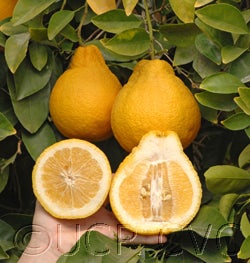Citrus natsudaidai
CRC 3235
PI 539453
Source
Received as seed from Hiroshi Yoshimura, Tanaka Institute, University of Osaka, Japan, 1957. Open pollinated seedling.
Parentage/origins
Parents unknown. Believed to have originated from seed that drifted ashore in Yamaguchi, Japan.
Rootstocks of accession
Carrizo citrange, C-35 citrange
Season of ripeness at Riverside
February to April
Notes and observations
Notes from W.P. Bitters' 1963 trip to Japan: Late maturing species of citrus in Japan, usually grown in coastal areas. Tree large & vigorous, from 400-500 grams, shape is oblate, rind 5-6 mm, leaves small winged, average petiole. Color against commercial use; also extreme seediness.
From Citrograph 72(2): 29-30, 32, Dec. 1986: Natsudaidai is believed to have originated from a seed that drifted ashore in Yamaguchi Prefecture (Japan) about 1870. It seems to be a hybrid of pummelo and another citrus. In Japanese Natsu means summer and Mikan means Citrus: thus, Natsumikan (synonym for Natsudaidai) means summer citrus. The fruit are large (400-500 g), have a thick skin and 30 seeds on average, taste very sour, and contain 2-3% acid. An early-maturing cultivar that contains only 1-2% acid was found and named Kawano Natsudaidai (this accession) in 1950. Generally, the less-acid type of Natsumikan is called Amanatsu (includes Kawano Natsudaidai).--more information continues in this article.
2/23/1988, EMN: Dr.Bitters says this is NOT Natsumikan and Mikan does not mean Citrus; Fruit is light yellow and rough rinded. Rind relatively thick like a pummelo but flesh is more juicy and melting, like a grapefruit. Sour now to my taste.
WPB: Should put with Sour orange hybrids.
5/27/1988, EMN: Decently sweet flavored now, but flesh is coarse appearing and most fruits are granulating, especially at the stem end. This would not be commercial here.
3/3/2008, DK & TS: Tree has large leaves. Fruit has a necked pummelo-like shape; medium to golden orange yellow; rind thick, pebbly, prominent glands; juice vesicles coarse but tender; 8 to 10 seeds; flesh juicy, light orange, sweet, but with an aftertaste. Is this really a sour orange hybrid, or was it just the "daidai" part of the name that suggested that identity?
Availability
Not commercially available in California.
USDA Germplasm Resources Information Network page for Kawano natsudaidai sour orange hybrid


